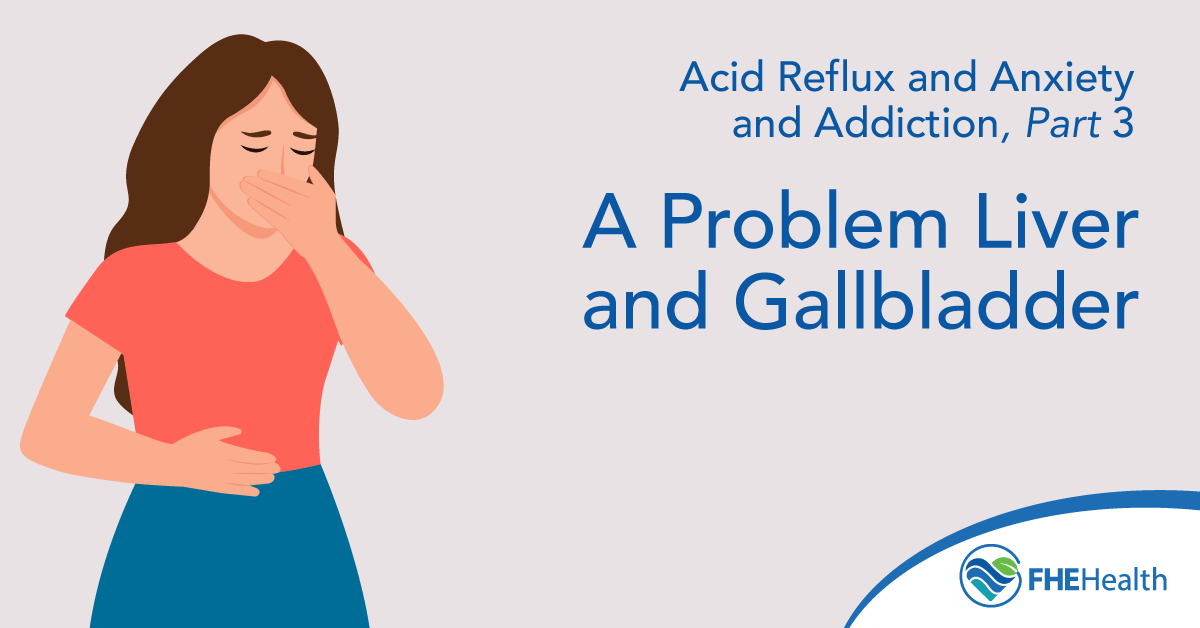
If you’ve been treating your reflux with acid-reducing medications and still aren’t getting relief, you’re not alone — and you’re not imagining things. For many people, especially those who have had their gallbladder removed or are dealing with sluggish bile flow, the problem isn’t just stomach acid. It could be bile reflux, bile insufficiency, or other issues with bile flow, all of which can mimic or worsen typical GERD symptoms.
In this post, we’ll explore how the liver and gallbladder play a hidden but critical role in digestive health, why traditional reflux treatments like PPIs may not always help (and in some bile-related cases, may even make symptoms worse), and how to identify signs that your symptoms are related to bile, not acid. We’ll also cover evidence-based strategies to support bile flow and restore digestive balance. These are especially important if you’re navigating life without a gallbladder.
Let’s dive into the often-overlooked role of bile in reflux and uncover what to do when the liver and gallbladder are the real culprits; but first, here are some key terms to know:
- PPI (Proton Pump Inhibitor): A medication that reduces stomach acid. Commonly prescribed for acid reflux and GERD.
- Barrett’s Esophagus: A condition in which long-term acid reflux changes the lining of the esophagus, increasing the risk of esophageal cancer.
Bile vs. Acid Reflux: What’s the Difference?
Acid reflux occurs when stomach acid flows back into the esophagus due to a weakened lower esophageal sphincter (LES). Bile, on the other hand, is excreted from the gallbladder, or directly from the liver if the gallbladder has been removed, and plays a key role in fat digestion.
Bile reflux happens when bile backs up into the stomach and, in some cases, into the esophagus. Although bile is alkaline, it can actually be more damaging to the esophagus than stomach acid (2). The symptoms of bile reflux often overlap with those of acid reflux: burning pain, nausea, bloating, or a bitter taste in the mouth. In some cases, both bile and acid reflux can occur together. Bile reflux may be more likely if:
- You have little or no improvement from acid-lowering medications
- Your symptoms worsened after gallbladder removal (cholecystectomy)
- You have severe reflux conditions like Barrett’s esophagus or esophagitis
How common is bile reflux?
- One study found that over 60 percent of individuals who had their gallbladder removed had bile reflux, compared to 17% of those who had not (1).
- Among GERD patients who did not improve on high-dose PPIs, 53 percent without esophagitis and 70 percent with esophagitis were found to have bile reflux. This suggests a high prevalence of bile reflux among PPI non-responders (2).
- Bile reflux was significantly more common in those with severe forms of reflux, such as esophagitis and Barrett’s esophagus (2). A large-scale study also identified bile reflux as an independent risk factor for developing Barrett’s esophagus (7).
Signs of Bile Insufficiency and Gallbladder Dysfunction
Gallbladder dysfunction or sluggish bile flow can contribute to poor fat digestion and gastrointestinal distress that mimics or worsens reflux. Common signs include:
- Greasy, floating stools
- Upper right abdominal discomfort
- Bloating or nausea after fatty meals
- Fat-soluble nutrient deficiencies (A, D, E, K)
- Light-colored stools or dark urine
After gallbladder removal, the liver assumes the role of regulating bile secretion. However, it often takes time for the liver to adjust and release appropriate amounts of bile at the right times. Some individuals adapt more quickly than others, while some may never fully return to normal bile regulation and could require long-term support or dietary modifications.
Contributing Factors and Root Causes
In Part 2, we discussed how sluggish motility contributes to GERD. These same motility issues also play a role in bile reflux (1). Additional contributors include:
- Inflammation
- Surgery in the upper digestive tract
- Factors that affect gastrointestinal hormones involved in bile regulation
Lifestyle factors like smoking and alcohol can also trigger bile reflux by weakening the pyloric sphincter, the valve between the stomach and small intestine that normally prevents bile from backwashing into the stomach (1). While PPIs are effective at reducing acid reflux, they’ve been shown to worsen bile reflux (3). This may be due to their known effects on slowing gut motility (4) and altering gut pH, which can disrupt the release of bile-regulating hormones like cholecystokinin (CCK).
What About Bile Insufficiency?
There is limited research on the root causes of bile insufficiency, but it may contribute to reflux through a different pathway:
- Dysbiosis (gut flora imbalance) has been shown to reduce secondary bile acid production (5).
- Low bile slows digestion and transit time (6), increasing reflux risk by prolonging gastric retention.
- Reabsorption: Bile is reabsorbed in the ileum (the last part of the small intestine). If this area is affected by inflammation, damage, or surgery, bile reabsorption may be impaired. Over time, chronic bile malabsorption can lead to bile insufficiency (8).
Restoring Balance: Supporting Bile Flow and Liver Function
If bile production or flow is impaired, improving it can significantly ease reflux symptoms. Here are evidence-based strategies to support liver and gallbladder health:
1. Bitters
Certain bitters are shown to support digestive motility, which can indirectly enhance bile flow. Others, such as artichoke leaf extract, have demonstrated not only motility benefits but also the ability to directly stimulate bile production (9) and protect the liver in multiple ways (10–11).
Dark leafy greens are considered natural bitters. Studies show associations between their consumption and improved bowel movements (12–13), though it’s unclear whether the benefits come from their bitter compounds or their fiber content. Regardless, dark, bitter leafy greens have been shown to promote bile flow (14) and support liver protection (15).
Incorporating dark leafy greens and ginger into your daily routine can be a simple and effective way to support liver and gallbladder function. Herbal teas such as dandelion, fennel, artichoke leaf, wormwood, or angelica root can also be beneficial if you suspect motility or bile flow issues are contributing to your reflux.
Bitter-based supplements like Iberogast have been studied for their impact on motility and acid reflux. While one study showed some benefits for reflux (16), the results were not statistically significant in most GERD-related outcomes. This may be due to a small sample size, or it could reflect the varied root causes of reflux, since Iberogast may only be effective when reflux is tied specifically to bile or motility issues.
[Disclaimer: Avoid bitter supplements if you have gallstones or a bile duct obstruction.]
2. Taurine and Glycine
These amino acids assist in bile acid conjugation, improving its effectiveness. Taurine, in particular, supports both detoxification and gallbladder function. The Seeking Health Gallbladder Nutrients formula combines these with herbal bitters and other synergistic nutrients to provide comprehensive support for bile production and flow.
3. TUDCA (Tauroursodeoxycholic Acid)
A bile acid derivative known to enhance bile flow, reduce inflammation, and protect liver cells. It is especially beneficial following gallbladder removal. Compelling research supports its use across a wide range of conditions beyond liver health (17). Due to its broad benefits and superior research backing, I typically start with TUDCA before considering ox bile.
4. Ox Bile Supplements
These supplements can help replace or support natural bile production in individuals with impaired bile output or those who have had their gallbladder removed. They are best taken with high-fat meals to enhance digestion and reduce the risk of reflux. While ox bile has been widely used for many years, it has not been as extensively studied as TUDCA.
After Gallbladder Removal: Special Considerations
Once the gallbladder is removed, digestive rhythms and bile flow can shift significantly. If your reflux symptoms haven’t improved or have become more bothersome since surgery, try the following strategies to support digestion and ease discomfort:
- Eat smaller, more frequent meals
- Avoid very high-fat meals (especially fried foods, cream-based sauces, and fatty cuts of meat)
- Stay well hydrated
- Include fiber-rich foods to support bowel motility and reduce bile salt reabsorption
- Incorporate digestive bitters through food, tea, or supplements
- Consider trying TUDCA or ox bile supplements with meals that contain fat
Final Thoughts
If traditional reflux treatments haven’t worked for you, it may be time to look beyond acid. Addressing bile dynamics, whether related to liver function, gallbladder health, or bile flow, can uncover a missing piece of the puzzle. This is especially true if your symptoms are triggered by high-fat meals. Whether you’re dealing with bile insufficiency, sluggish bile flow, or adjusting to life after gallbladder removal, targeted digestive support can offer real relief.
Coming Up Next: In Part 4, we’ll explore what to do when reflux truly is caused by too much acid and how to support healing from gastritis and ulcers naturally.






